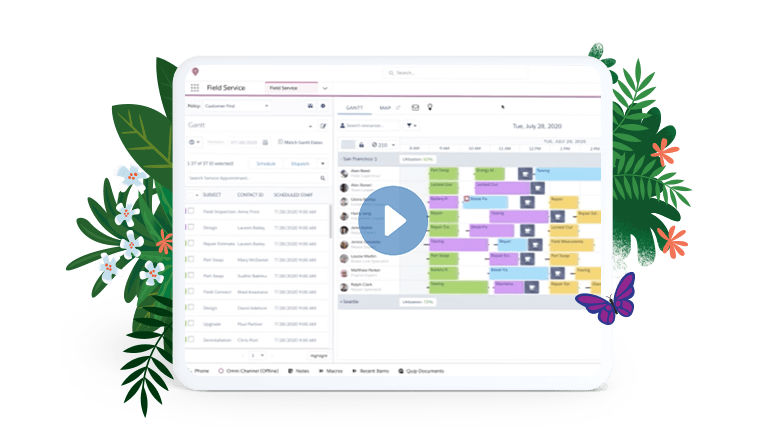3 Ways Automation Accelerates Field Service Management for Utilities
Discover how field service automation improves customer and employee experiences and drives operational efficiency for utilities.

Editorial Lead, Senior Manager, Salesforce
Automation improves field service management for utility companies. It simplifies processes and streamlines repetitive tasks. This way, utility companies ensure service continuity, shorter resolution times, and cost efficiencies. They can also develop data-driven strategies to perform essential work better and faster.
Let’s look at how utility companies benefit from automation in field service management.

The benefits of automation in field service management for utility companies
Automation takes this approach to field service management to the next level. Artificial intelligence (AI) enables automation by analyzing data. Based on this data, AI predicts next steps and key actions.
Automation increases workforce productivity, faster resolutions, and improved first-time fix rates. This is due to standardized workflows that automate tasks and predict next steps. There are cost benefits, too. According to Capgemini, utility companies could save between $237 billion and $813 billion over three years with automation at scale. However, the utility sector has largely underestimated the potential for automation.
“Field service teams are already doing a great job without automation. With automation, they enjoy their work and reduce stress. At the same time, they improve productivity and first-time fix rates.”

Sr. Director of Product Management and Strategy for Energy & Utilities, Salesforce

3 use cases for automation in field service management
1. Automate scheduling and dispatching to deliver service faster
- Reduce the possibility for manual errors and bias. Capture key information during the customer interaction. Create a new service ticket with a set of requirements. Automation matches the right field service utility workers, crews, and tools for the job.
- Respond faster, at scale. Get customers the help they need, fast. Automated scheduling saves precious time, especially when a customer has an emergency. Dispatchers are able to devote more time to providing empathetic service to customers. Meanwhile, they are able to dispatch field service utility workers to the job site to resolve the issue.
- Adapt to last-minute changes. Whether it’s a late arrival or delayed job, all team members receive real-time updates. This helps the field service utility team stay agile and adapt to change.
- Speed up onboarding. Teams don’t waste time toggling between systems to figure out what to do next. Employees and contractors get up and running fast with automated workflows. They access these workflows from their mobile app. The workflows guide them through key steps to ensure first-time fix rates.
- Reduce the possibility for manual errors and bias. Capture key information during the customer interaction. Create a new service ticket with a set of requirements. Automation matches the right field service utility workers, crews, and tools for the job.
- Respond faster, at scale. Get customers the help they need, fast. Automated scheduling saves precious time, especially when a customer has an emergency. Dispatchers are able to devote more time to providing empathetic service to customers. Meanwhile, they are able to dispatch field service utility workers to the job site to resolve the issue.
- Adapt to last-minute changes. Whether it’s a late arrival or delayed job, all team members receive real-time updates. This helps the field service utility team stay agile and adapt to change.
- Speed up onboarding. Teams don’t waste time toggling between systems to figure out what to do next. Employees and contractors get up and running fast with automated workflows. They access these workflows from their mobile app. The workflows guide them through key steps to ensure first-time fix rates.
2. Speed up the time to a job site
Route optimization uses automation to provide the most efficient route to a job site. This capability evaluates the entire workday for each resource. It accounts for factors such as:
- Time of appointment
- Length of job
- Historical traffic patterns
- Proximity to job site
It can keep a worker within a specific geographical area to cut their time in traffic. And it schedules consecutive stops close to one another. Route optimization also chooses a start time that avoids the heaviest traffic patterns.
The benefits for the utility company include lower fuel expenses and less time in the truck. Meanwhile, customers receive service faster, which improves satisfaction.
3. Simplify workflows to improve first-time fix rates
Field service utility workers often tackle repetitive, cumbersome processes. These processes need them to navigate many technology systems. Automation simplifies these processes while supporting field service utility workers during complex jobs. For example, an automated workflow can provide detailed instructions to complete a job.
Let’s say a worker is replacing water valves at a municipal building. Each valve requires particular instructions for proper replacement. The workflow takes into account common features and functions. It guides the worker through the recommended steps to complete the job. If they need more support, they can review knowledge articles or videos from their mobile app. They can also connect to an expert with visual remote assistance.
Once they complete the job, field service utility workers add updates in real time. This includes expense reports and avoids cobbled-together paperwork. This is a key benefit because the faster a utility company signs off on the job, the faster workers get paid.
How automation improves decision-making for utilities
How automation unlocks new revenue opportunities

Get started with automation in your utility company
Ready to adopt automation for your field service utility workforce? Focus your efforts where automation can offer the quickest wins with the most impact. This will help you build internal support for more widespread adoption. Take these steps:
- Outline the plan for one use case. For example, you might automate scheduling by removing it from spreadsheets or email. Manage change.
- Explain the benefits of automation to the team. Answer their questions and ease any concerns. Provide training to get team members up to speed and comfortable.
- Listen to their feedback and incorporate it as you go.
- Share the results and the benefits across the team.
- Show how automation improves key metrics such as productivity and first-time resolutions.
- After completing your first use case, expand to others. You might tackle workflows next for asset maintenance.
Utility companies that adopt automation meet customer expectations for service continuity. Complete repetitive tasks in minutes rather than hours or days. Help employees take their expertise to the next level and deliver essential field service faster. And enable the entire team to benefit from an accurate, real-time view of data.

Why the Future of Utilities Is All About Adding Value to Customer Experience

Being Human in the Time of Automation

Deliver Service Anytime, Anywhere with Visual Remote Assistance
About the Author

Jill Wagner
Editorial Lead, Senior Manager, Salesforce
Jill Wagner is an editorial lead and senior manager at Salesforce. She joined Salesforce through the ClickSoftware acquisition. Jill is an award-winning marketing communications professional, experienced in conceptualizing and creating marketing content for leaders in the SaaS and manufacturing spaces. She has a Bachelor of Science in Marketing from Bentley University and a Master of Arts in Advertising and Marketing from Emerson College. Connect with Jill on LinkedIn.
More resources

Agility Matters for Utilities. Can Your Field Service Management Adapt?

The Fastest Route to Field Service Success



